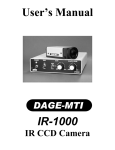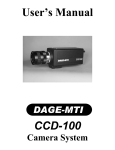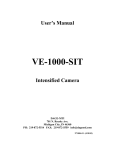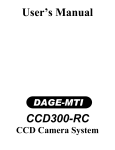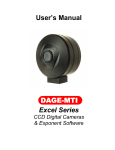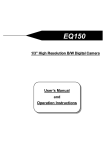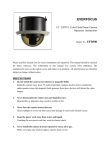Download DAGE-MTI DC-200 User`s manual
Transcript
User’s Manual DAGE-MTI DC-200 Color Camera Purchaser’s Record Model Name: DAGE-MTI DC-200 Serial Number: Dealer’s Name: Dealer’s Address: Dealer’s Phone Number: Date Purchased: P.O. Number: Introduction The DAGE-MTI DC-200 is a compact color camera based upon a single 1/3” Interline CCD that provides a high resolution color image. The CCD employs a state of the art microlens design to increase the light gathering capability of the CCD. Digital Signal Processing (DSP) is employed to provide ultimate video enhancement and function. A convenient remote setup keypad is included to utilize the On Screen Display (OSD) commands to set white balance, shutter, gain, back-light compensation, and an eight character camera title. The DC-200 also employs automatic edge enhancement and automatic black balance. Whether using the camera in a fully automatic mode or in a manual mode, memory back-up of camera settings allows you to “set and forget” so you can spend your time productively obtaining the images needed to perform your job. DAGE-MTI offers our customers state-of-the-art video technology… with an eye on your image. Installation MONITOR VIDEO(COMP) OR Y/C VIDEO OSD KEYBOARD Y/C TI -M E G 0 DA 20 C D DC 12V 12V, 200mA OSD REMOTE Figure 1: DC-200 Connections Power The red LED located on the camera front lights when power is supplied to the camera. The camera requires approximately 200mA at 12VDC. The external power supply, Dage P/N 738044-02, provides the correct power to the camera. Video The Video BNC connector provides a NTSC (or PAL) composite video signal to be terminated into 75 Ω. For improved video performance, the Y/C video output signal should be used when possible. Y/C The Y/C or sometimes referred to as “S Video” connector provides Y (luminance) and C (color) signals to be terminated into 75Ω. Because the signals are separate and not combined like the composite output is, a higher quality image can be obtained. OSD Keyboard The OSD Keyboard connector is used with the OSD Remote to adjust camera functions such as white balance, shutter, gain, back light compensation, and the eight character camera title. The keyboard settings are stored in memory, so it is only necessary to attach the remote when it is desired to change settings. The camera Power should be removed when connecting and disconnecting the remote. Operation Connect the DC-200 to the OSD Remote and Monitor, then apply Power. Push the MENU button on the remote to activate the On Screen Display Menu, which should be similar to the display shown in figure 2. By pressing the MENU button again, the settings displayed will be stored and menu display will turn off. Figure 2: OSD Menu The active editable menu function will be flashing. Use the UP, DOWN, LEFT, RIGHT buttons to move through menu items and change settings. For example, to change the shutter setting from off to auto: 1. Press MENU. WHITE BALANCE will be flashing. 2. Press DOWN. SHUTTER will be flashing. 3. Press RIGHT. OFF will be flashing. 4. Press UP or DOWN to scroll through the available settings, when AUTO appears, stop. 5. Press MENU to store AUTO and turn off display, or press LEFT then UP or DOWN to edit other menu items in a similar matter. NOTE: When editing MANUAL WHITE BALANCE and CAMERA TITLE, an additional RIGHT press is needed to activate the adjustment cursor, then UP/DOWN to change values and LEFT/RIGHT to change characters as necessary. White Balance One Push: By pressing the ONE PUSH (AWB) on the remote, the camera automatically white balances to the present scene, then stores setting until ONE PUSH is pressed again or camera power is turned off. When camera power is turned back on a ONE PUSH (AWB) cycle is performed. Pressing the ONE PUSH button automatically changes the White Balance menu setting from the previous setting to the ONE PUSH setting. There must be adequate white area in the scene and illumination to perform a white balance or the camera will wait before completing the white balance. The typical method of white balancing in this mode is to set the illumination level, place a white object in the scene (if there is not enough white in scene), then press ONE PUSH. ONE PUSH (AWB) should be readjusted when light intensity is changed. Auto (ATW): This setting places the camera into Auto Tracking White balance mode. In this mode the camera continuously measures the object color temperature and adjusts the white balance automatically. There must be adequate white area in the scene and illumination to perform the white balance. Manual: The Manual White Balance mode allows the user to set the white balance. Adjustment is confirmed with a monitor or vector scope. White balance must be readjusted when light intensity is changed. When using the manual adjustment, the green channel is fixed and the adjustment is made by moving the manual cursor between blue and red with the UP and DOWN remote buttons. 3200°K: This fixed color temperature setting is approximated for indoor incandescent illuminated subjects. 4600°K: This fixed color temperature setting is approximated for indoor fluorescent illuminated subjects. 5600°K: This fixed color temperature setting is approximated for outdoor illuminated subjects. Shutter (Electronic Shutter) Off: Camera is set to standard 1/60 (1/50 PAL) second shutter. No excessive light shuttering is performed. Camera gain can be in Auto or Manual (AGC ON or OFF), but if illumination exceeds the minimum gain of the camera, overload of the video signal results. If viewing high illumination scenes, then set shutter to AUTO or one of the manual settings. Auto: The exposure time is controlled automatically from 1/60 (1/50 PAL) to 1/10,000 second to obtain the video level set. Camera gain can be in Auto or Manual (AGC ON or OFF). FLCless: (Flicker less) For use in fluorescence illumination when experiencing flicker problems associated between fast discharge of fluorescent lamps and the camera shutter. Fixed: Six fixed shutter settings are available. 1/250, 1/500, 1/1000, 1/2000, 1/4000, and 1/10,000 second. AGC On: The Automatic Gain Control automatically sets the camera video gain within a 0 to 30 dB range to provide the correct video output level. Off: The camera is in a non adjustable manual gain fixed mode in which the gain is set to minimum. This setting allows the best possible signal to noise ratio. Back Light If the scene has too much Back Light (light behind the subject) the AGC (Automatic Gain Control) and Auto Shutter circuits may adjust to the back light instead of the subject. Use the Pattern which provides the best picture. The Back Light function works only when AGC and/or Auto Shutter are on and the illumination level is sufficient for the automatic circuits to function. Ptrn.1: Provides highest amount of compensation. Ptrn.2: Provides moderate amount of compensation. Off: Provides no Back Light compensation. Camera Title The Camera Title provides eight characters of lower or upper case letters or numbers or symbols. To edit the title, use the OSD Remote. Press MENU, then DOWN until CAMERA TITLE flashes, then RIGHT, then DOWN until ON appears, then RIGHT again. Now the first character of title will be flashing. Press UP or DOWN to change the character, then press RIGHT to move to the next character. Repeat this until all characters have been edited. Press MENU to exit and store, or LEFT to return to other menu items. Iris CCD Iris: This setting sets the camera into AUTO SHUTTER. (changes shutter setting to auto) CS Mount: This setting sets the camera SHUTTER to OFF. (changes shutter setting to off) Focus Adjustment (mechanical back-focus) The Back-Focus is calibrated at the factory and should not need readjustment, however if adjustment is necessary follow the procedure below: 1. Loosen the set screws on the top and bottom of front casting with a 1.5mm hex wrench. 2. Set the lens to maximum aperture and to ∞ focus position. 3. View an object which is 20M or more away, then adjust lens mount ring until the image is in focus. 4. Tighten the set screws. Connector pin-outs OSD Keyboard Connector This 8 pin connector is used for the OSD Remote to set-up or change camera function settings. The pin-out is as follows: 1. RIGHT 2. LEFT 3. UP 4. DOWN 5. MENU 6. ONE PUSH(AWB) 7. GROUND 8. N/C Y/C Video Connector This 4 pin connector provides Y (luminance) and C (color) output signals to be terminated into 75Ω. The pin-out is as follows: 1. GROUND 2. GROUND 3. Y (LUMINANCE) 4. C (COLOR) Specifications: CCD Sensor: 1/3” Interline /w Micro Lenses NTSC: 768x494 Effective Pixels PAL: 752x582 Effective Pixels Sensitivity: 0.015fc, (0.15 lux) /w AGC on Horizontal Resolution: 480 TVL Vertical Resolution: 375 TVL-NTSC / 450 TVL-PAL Signal to Noise: 50dB (AGC off, Y signal) AGC Range: 30dB Digital Processing: 9 Bits Edge Enhancement: 2H Horizontal & Vertical Memory Back-up: EEPROM (non volatile) Auto White Balance: 3000°K to 8000°K Video Output: 1Vpp, 75Ω comp & Y/C Gamma Correction: .45 Electronic Shutter: Auto from 1/60 to 1/100,000s Manual Shutter: 1/60, 1/250, 1/500, 1/1000, 1/2000, 1/4000, 1/10,000 Lens Mount: “C” or “CS” Camera Mount: ¼-20, Top or Bottom Mount Dimensions: 2 7/16”W x 2 1/16”H x 2 11/16”L Weight: 8.6 Ounces Power: 2.4W (12VDC, 200mA) Operating Temperature: 0°C to +50°C Troubleshooting No Picture (Check or try the following): 1. Camera Power On? a. External Power Supply Attached? b. AC Power On? c. LED on Camera Front On? 2. Monitor Connected to Camera Video Output? a. Monitor Power On? 3. Light Level Too Low? a. Open Camera Lens. b. Set Camera Shutter to Auto or Off. c. Set Camera AGC to On. Picture Saturated (Check or try the following): 1. Video Output Cable Terminated Into 75Ω? 2. Light Level Too High? a. Reduce Lens Setting. b. Set Camera Shutter to Auto. c. Set Back-Light Compensation to Off. Warranty The DAGE-MTI DC-200 is warranted to be free of defects in material and workmanship in normal use for a period of one year from the original date of purchase from DAGE-MTI. This warranty does not apply to units which have been subject to abuse, neglect, accident, improper installation, or on which the serial number has been removed or damaged. Units that have been altered without the prior permission of DAGE-MTI are not covered by this warranty. This warranty does not apply to other equipment furnished by DAGE-MTI, which is listed or otherwise identified as manufactured by another and therefore shall be covered by the other manufactures’ applicable warranty. Limitations 1. This warranty is valid only if the malfunctioning unit is returned to DAGE-MTI service depot. This warranty does not cover on-location service. If warranty work is needed, the following should be contacted: DAGE-MTI, INC. Customer Service 701 N. Roeske Ave. Michigan City, IN 46360 (219) 872-5514 Fax: (219) 872-5559 [email protected] 2. This warranty does not cover: a. Problems caused by or inflicted upon associated equipment such as digitizing systems, video tape recorders, cameras, microscopes, etc. b. Damage caused by accident, misuse, improper power source, fire, flood, lightning, other acts of God, war, and repair or alteration by other than a DAGE-MTI authorized service organization. c. Labor or incurred charges required in removing or installing the Product, down time, failure of the Product to perform properly, and any consequential damages. d. Transit damage. 3. Unit must be properly packaged (in original packing, if possible) when being returned under warranty. DAGE-MTI Inc. 701 N. Roeske Ave. Michigan City, IN 46360 (219) 872-5514 Fax: (219) 872-5559 E-mail: [email protected] http://www.dagemti.com 970204-01 8/5/02
















